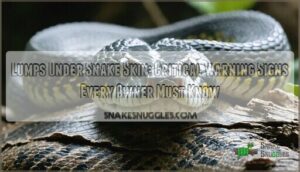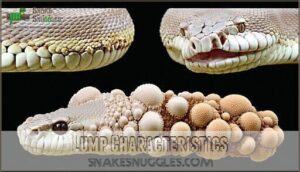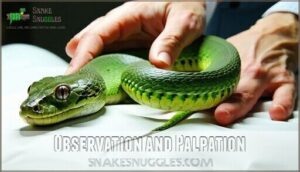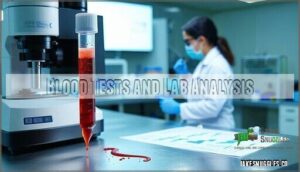This site is supported by our readers. We may earn a commission, at no cost to you, if you purchase through links.
 Lumps under snake skin can signal serious health issues that need your immediate attention.
Lumps under snake skin can signal serious health issues that need your immediate attention.
These bumps might indicate bacterial infections, abscesses, parasitic infestations like mites or ticks, or even tumors.
You’ll typically spot them around the vent, mouth, eyes, or along the body.
External lumps are easier to see, while internal ones may cause visible swelling.
Watch for changes in your snake’s behavior, eating habits, or movement patterns alongside these physical signs.
Some lumps feel soft and squishy, others hard and firm.
Don’t wait and hope they’ll disappear – early detection makes all the difference in treatment success and your snake’s recovery.
Table Of Contents
- Key Takeaways
- Snake Skin Infections
- Causes of Lumps
- Identifying Lumps
- Common Snake Diseases
- Fungal Diseases
- Diagnosing Lumps
- Treating Lumps
- Preventing Skin Issues
- Snake Shedding Issues
- Maintaining Snake Health
- Frequently Asked Questions (FAQs)
- What if a snake has a lump?
- Are lumps on pet snakes normal?
- How do you know if a snake has a neoplasia?
- Do snakes have skin problems?
- Can a snake have a pus scab?
- How do you know if a snake is slithering?
- Why would a snake look lumpy?
- What causes tumors in snakes?
- How to know if a snake has a blockage?
- Can lumps disappear without veterinary treatment?
- Conclusion
Key Takeaways
- Don’t wait when you discover lumps – You need immediate veterinary attention because these bumps can signal serious infections, parasites, or tumors that worsen quickly without treatment.
- Look for warning signs beyond the lump itself – Watch for changes in your snake’s eating habits, movement patterns, or behavior alongside physical bumps, as these indicate the severity of the condition.
- Prevention beats treatment every time – You’ll avoid most lump problems by maintaining proper humidity, temperature, cleanliness, and regular health monitoring in your snake’s habitat.
- Professional diagnosis is essential – You can’t safely determine if a lump is harmless or dangerous on your own, so contact an exotic veterinarian for proper identification and treatment plans.
Snake Skin Infections
When you discover lumps under your snake’s skin, you’re facing a potential health crisis that demands immediate attention.
These mysterious bumps can signal bacterial infections, fungal diseases, or parasitic infestations that threaten your pet’s life if left untreated.
Bacterial Infections
Bacterial infections create snake skin lumps that demand immediate attention.
Those mysterious bumps beneath your snake’s skin could spell serious trouble ahead.
These firm abscesses form when bacteria invade through wounds, bites, or parasite damage.
Poor husbandry increases infection risk substantially.
You’ll notice swollen, painful lumps with possible discharge.
Antibiotic options and wound care require veterinary guidance.
Systemic infections can become life-threatening without prompt abscess treatment and proper infection prevention measures.
Most bacterial pathogens are gram-negative bacteria.
Fungal Infections
Fungal infections thrive in damp environments and create distinctive crusty scales on your snake’s skin.
These persistent organisms cause visible skin lumps that worsen without proper treatment.
- Ophidiomyces ophiodiicola – The primary fungus causing Snake Fungal Disease
- Crusty scale formation – Creates thick, hardened patches on affected areas
- Subcutaneous nodules – Lumps develop beneath the skin’s surface
- Environmental persistence – Fungus survives in soil and contaminated substrates
Veterinary consultation becomes necessary when you notice these fungal infections spreading across your snake’s body.
The disease, known as SFD, was first identified in Illinois in 2008.
Parasitic Infections
Beneath your snake’s skin, tiny invaders can create serious problems.
Hidden threats lurk beneath every scale, waiting to strike your snake’s health.
Parasitic infections manifest as subcutaneous masses from mites, ticks, or internal parasites like roundworms.
These unwelcome guests cause inflammation, secondary infections, and tissue damage requiring swift intervention.
| Parasite Type | Signs & Treatment |
|---|---|
| Mite Infestations | Visible crawling specks, skin irritation; environmental treatment + antiparasitic medications |
| Internal Parasites | Lumps under skin, weight loss; fecal testing + targeted deworming protocols |
| Tick Removal | Swollen attachment sites; careful extraction + wound care monitoring |
Snake parasites demand professional diagnosis since protozoal infections mimic other conditions.
Your vet will recommend specific antiparasitic medications based on parasite identification.
Causes of Lumps
Understanding what causes lumps under your snake’s skin helps you respond quickly when problems arise.
These mysterious bumps can stem from infections, parasites, tumors, or even simple issues like retained food, so knowing the possibilities guides your next steps, which can include addressing tumors.
Remote Work Productivity
Just like keeping your workspace organized boosts remote work productivity, a tidy snake habitat helps prevent skin issues and lumps.
Good communication strategies with your vet, time management for regular checks, and motivation techniques for daily care matter.
Ergonomic setup isn’t just for people—proper habitat supports snake health, work-life balance, and helps you spot snake lump causes, symptoms, diagnosis, and treatment early, which is crucial for maintaining a tidy snake habitat and ensuring work-life balance.
Team Collaboration Tools
Several factors beyond parasites and infections create snake lumps that demand your immediate attention.
Understanding these causes helps you identify when your pet needs urgent veterinary care.
- Tumors and growths develop slowly but require early detection
- Retained eggs cause visible swelling in female snakes
- Foreign objects create localized bumps under the skin
- Organ enlargement produces internal masses you can feel
These snake lump causes vary in severity, but proper snake lumps diagnosis guarantees effective snake lumps treatment for concerning snake lumps symptoms.
Hybrid Work Challenges
While working from home presents unique challenges, identifying snake lumps requires different expertise than remote collaboration.
Communication barriers between you and your vet can delay snake lumps diagnosis when describing symptoms over phone calls. Employee isolation mirrors how snake owners often handle snake lumps treatment alone, missing critical warning signs.
Tech disparities affect accessing snake lumps symptoms information online. Performance management of your snake’s health needs flexible scheduling for veterinary visits when discovering concerning snake lump causes under their skin, including critical warning signs, and requires understanding of snake lumps diagnosis, and the importance of veterinary visits.
Identifying Lumps
You’ll need to carefully examine any lump you find on your snake’s body to determine its severity and potential causes.
The location, size, and texture of these lumps provide essential clues about whether you’re dealing with a minor issue or a serious health emergency that requires immediate veterinary attention.
Location and Size
Where you find snake lumps matters as much as their size when determining lump severity.
Cranial third lumps often signal mouth infections or heart disease, while middle third swellings suggest internal organ issues.
Caudal third lumps near the vent indicate reproductive problems or constipation.
Growth rate and location significance help distinguish between snake abscesses, skeletal lumps, and snake cancer under snake skin.
External and Internal Lumps
External snake lumps appear on the surface, while internal swelling develops deeper within your pet’s body cavity.
External lumps from snake abscesses, cyst development, or tumor types feel firm under your fingers during gentle examination.
Internal snake swelling often indicates organ enlargement, egg retention, or serious conditions requiring immediate veterinary attention for proper diagnosis.
Lump Characteristics
Understanding lump texture helps you assess potential threats to your snake’s health.
Hard, immovable bumps often signal abscesses, while soft, squishy masses may indicate lipomas or fluid-filled cysts.
Growth rate and associated symptoms like skin changes or pain levels provide additional clues about snake lumps causes and underlying snake lumps conditions affecting your pet.
- Firm lumps – Usually abscesses or tumors requiring immediate veterinary attention
- Soft lumps – Often lipomas or cysts that move slightly under snake skin
- Crusted nodules – Typically indicate fungal snake lumps diseases like SFD
Common Snake Diseases
While lumps under your snake’s skin can signal various health issues, some diseases create more dangerous complications than others.
You’ll need to recognize mouth rot, stomatitis, and respiratory infections quickly since these conditions often cause internal swelling that mimics harmless lumps but requires immediate veterinary care, particularly for stomatitis.
Mouth Rot
Beyond surface-level concerns, mouth rot represents one of snake health issues requiring immediate attention.
This bacterial infection affects your snake’s oral cavity, causing painful swelling and discharge.
| Stage | Mouth Rot Symptoms | Action Needed |
|---|---|---|
| Early | Small red spots, mild swelling | Monitor closely, improve hygiene |
| Moderate | Yellow discharge, difficulty eating | Seek reptile veterinary care |
| Severe | Bleeding gums, facial deformity | Emergency treatment required |
Stomatitis causes include poor oral hygiene, stress, and inadequate temperatures.
Treating stomatitis involves antibiotic therapy and wound care.
Preventing mouth rot starts with maintaining proper humidity levels and clean water sources for superior snake medical care.
Stomatitis
Infectious stomatitis in snakes creates painful mouth sores that make eating difficult.
You’ll notice red, swollen gums with white or yellow discharge around teeth. Stomatitis causes include poor hygiene, stress, and bacterial infections that develop from mouth injuries.
Treating stomatitis requires immediate reptile veterinary care and antibiotic therapy. Oral examination during routine check-ups helps catch infections early, preventing serious snake health complications, which can be managed with proper reptile veterinary care.
Respiratory Infections
While mouth infections affect eating, respiratory illness strikes your snake’s breathing system with equal severity.
You’ll notice wheezing, mouth breathing, or discharge from the nostrils as pneumonia symptoms develop. Bacterial infections and fungal infections both cause respiratory illness, requiring immediate antibiotic treatment or nebulizer therapy to prevent fatal complications.
- Monitor humidity levels – Keep enclosure at 50-60% to prevent respiratory stress and support healthy breathing
- Watch for early symptoms – Wheezing, open-mouth breathing, and nasal discharge signal immediate veterinary attention needed
- Follow preventative care – Regular habitat cleaning and proper temperatures reduce snake diseases before they start
Fungal Diseases
You’ll recognize fungal infections by their crusty scales, discolored patches, and distinctive lumps that develop on your snake’s skin.
These diseases thrive in damp conditions and can quickly progress from minor skin irritation to serious health complications requiring immediate veterinary attention, which often involves treating fungal infections.
Snake Fungal Disease
Snake Fungal Disease (SFD) represents one of the most serious fungal infections threatening snake populations today.
Caused by Ophidiomyces ophiodiicola, this environmental pathogen spreads through contaminated soil and direct contact between snakes.
You’ll recognize SFD by facial swelling, crusty scales, and skin nodules that don’t improve with normal shedding.
Environmental factors like stress increase transmission risks, making SFD prevention through proper biosecurity measures essential for your snake’s health.
Fungal Rot
Fungal rot presents as brown or white discoloration across your snake’s scales, creating patches that look distinctly unhealthy.
You’ll notice this fungal discoloration most often in damp environments where moisture accumulates.
The scale appearance becomes rough and damaged, making identifying fungus straightforward once you know what to watch for.
Treatment options include antifungal medications and habitat corrections to eliminate excess humidity that promotes snake skin fungal infections.
Body Fungus
Your snake’s body fungus presents as red, swollen skin with distinctive bumpy textures that feel rough to touch.
Fungal discoloration creates patches ranging from brown to white, while cracked nails signal advanced fungal disease progression.
You’ll notice redness causes immediate concern, especially when combined with swollen areas.
Snake skin fungal infections require fungal cultures for proper diagnosis, as body fungus mimics other skin conditions and delays treatment, leading to advanced fungal disease progression.
Diagnosing Lumps
When you discover a lump on your snake, proper diagnosis requires three key approaches to determine what you’re dealing with.
Start with careful observation and gentle palpation, then consider imaging like X-rays for internal issues.
Observation and Palpation
**The key to detecting lumps lies in methodical observation and gentle palpation techniques.
**Start by examining your snake’s skin texture and scale condition under proper lighting.
- Check lump mobility – gently press to see if it moves or feels fixed
- Assess pain response – watch for defensive reactions during examination
- Note skin texture changes – rough, discolored, or raised areas
- Examine scale condition – missing, damaged, or abnormal scales around lumps
- Watch behavioral clues – decreased appetite, lethargy, or defensive posturing
Proper snake physical examination requires patience and systematic lump identification techniques.
Imaging Modalities
Modern diagnostic imaging transforms guesswork into precise identification of internal lumps.
X-ray use reveals bone changes and organ enlargement, while ultrasound imaging differentiates cysts from solid masses.
CT scans provide detailed cross-sections for complex cases, and MRI scans offer exceptional soft tissue contrast.
These diagnostic methods guide targeted biopsies and surgical planning for accurate treatment decisions.
Overcrowding and poor hygiene can lead to bacterial skin infections (bacterial skin infections) which require precise identification and accurate treatment to prevent further complications.
Blood Tests and Lab Analysis
Blood tests provide laboratory confirmation when imaging alone can’t identify lump causes.
Your veterinarian will analyze blood cell count for infections and run parasite detection screens.
Culture results from fine needle aspirates help identify bacterial or fungal growth.
Biopsy analysis and toxin screening complete these diagnostic methods, giving you definitive answers about your snake’s condition, including laboratory confirmation.
Treating Lumps
When you discover lumps under your snake’s skin, quick action makes all the difference between a simple fix and a serious health crisis.
Professional veterinary care provides the expertise needed to determine whether surgical removal, targeted medication, or specialized therapy will best address your pet’s specific condition.
Veterinary Care
Professional veterinary care transforms snake lump diagnosis from guesswork into precise medical assessment. Exotic veterinarians possess specialized training in reptile anatomy, while emergency treatment protocols guarantee rapid intervention when lumps appear suddenly or change dramatically.
- Reptile veterinarian examining your snake with specialized diagnostic equipment
- Specialist referrals connecting you to advanced exotic animal treatment centers
- Post-op care instructions detailing medication schedules and wound monitoring
- Preventative medicine consultations establishing regular health screening protocols
- Emergency treatment facilities equipped for urgent snake medical situations
Surgical Intervention
When serious lumps persist or grow rapidly, surgical intervention becomes your snake’s lifeline.
Your exotic veterinarian will use aseptic technique for abscess removal, tumor excision, or cyst removal procedures under anesthesia. One potential cause could be parasitic or bacterial infections, requiring immediate attention.
| Procedure Type | Recovery Time | Success Rate |
|---|---|---|
| Abscess Removal | 4-6 weeks | 95% |
| Tumor Excision | 6-8 weeks | 80% |
| Cyst Removal | 3-4 weeks | 98% |
| Foreign Objects | 2-3 weeks | 99% |
| Complex Surgery | 8-12 weeks | 70% |
Post-op care requires extended healing periods.
Medication and Therapy
Your vet will prescribe targeted treatments based on your snake’s specific condition.
Antibiotic options like enrofloxacin treat bacterial infections, while antifungal treatments such as itraconazole combat fungal diseases.
Parasite control medications eliminate mites and ticks effectively.
Snake lump treatment requires proper pain management during recovery.
Many owners purchase snake antibiotics for their pets.
Surgical aftercare includes topical antiseptics and supportive care to prevent complications and promote healing.
Preventing Skin Issues
You can prevent most lumps and skin problems by maintaining proper environmental conditions and following good husbandry practices.
Regular monitoring and preventive care will keep your snake healthy and catch potential issues before they become serious problems, which is crucial for maintaining a healthy snake through regular monitoring.
Environmental Changes
Environmental changes create the foundation for healthy snake skin and prevent dangerous lumps from forming.
You’ll need proper humidity control, temperature gradients, and adequate enclosure size to maintain your snake’s immune system.
Maintaining the correct humidity is essential, so consider specialized humidity products.
Choose appropriate substrates and maintain excellent habitat hygiene, as poor environmental conditions weaken skin defenses and increase infection risks that cause problematic lumps.
Proper Nutrition and Hygiene
Feeding your snake a balanced diet prevents nutritional deficiencies that weaken immune systems and increase infection risks.
Clean water quality matters equally—stagnant bowls breed harmful bacteria. Regular enclosure cleaning removes waste buildup, while proper handling practices minimize stress-related health problems.
One should also consider daily waste removal to control odors. Most captive snakes don’t need supplementation with appropriate prey items.
Regular Check-ups
Scheduling regular checkups with a reptile vet helps catch problems before they become serious.
Early detection through veterinary visits gives your snake the best chance at a healthy life.
Here’s what to expect during snake veterinary care:
- Physical examination – Your vet will check for snake lumps and skin abnormalities
- Weight monitoring – Tracking changes that indicate health issues
- Preventative care – Discussing habitat improvements and nutrition
- Health monitoring – Establishing baseline values for future comparisons
- Owner observation training – Learning what warning signs to watch for at home
Snake Shedding Issues
Your snake’s shedding process can reveal important health issues, especially when lumps appear during this vulnerable time.
Understanding normal shedding patterns helps you spot problems like retained skin pieces or underlying infections that create suspicious bumps.
Pre-shedding Signs
You’ll notice cloudy eyes and bluish skin when your snake approaches snake skin shedding time.
These pre-shedding signs indicate normal shedding frequency cycles, though behavior changes may occur during this period.
Your snake’s appetite might decrease, affecting diet impact on the process, and monitor for abnormal shedding patterns or persistent snake skin problems that could signal underlying snake skin issues requiring attention.
Post-shedding Care
Once your snake completes shedding, you’ll need to inspect the shed skin and your pet carefully. Check for retained skin pieces, particularly around the tail tip and eye caps, which can restrict blood flow if left attached.
Post-shedding care checklist:
- Post-Shed Inspection – Examine your snake thoroughly for any remaining skin patches that didn’t come off completely
- Retained Skin removal – Gently remove stuck pieces with warm, damp cotton swabs or seek veterinary help
- Scale Damage assessment – Look for any tears, cuts, or abnormal shedding patterns on the new skin
- Hydration Importance – Make certain fresh water availability as shedding can be dehydrating for your snake
- Habitat Readjustment – Return humidity levels to normal ranges after the higher pre-shed humidity period
Dehydration and Shedding
After your snake completes its shed, watch for dehydration signs that affect future shedding cycles.
Wrinkled skin and retained eyecaps signal low humidity levels. Water soaking helps restore skin elasticity when shedding difficulty occurs.
Monitor your snake’s skin peeling process closely.
| Dehydration Signs | Solutions |
|---|---|
| Skin wrinkling | Increase humidity levels |
| Retained eyecaps | Warm water soaking |
| Poor skin elasticity | Humidity monitoring |
| Incomplete snake shedding | Professional assessment |
Maintaining Snake Health
You’ve got the power to prevent most snake health problems before they start.
Creating the right environment, feeding properly, and watching your snake closely will catch issues like lumps before they become serious threats, this can be seen as a way to prevent most problems.
Clean and Safe Habitats
Your snake’s home environment directly impacts skin health and lump prevention.
Proper habitat hygiene stops infections before they start. Regular cleaning is also essential for optimal snake wellbeing.
- Substrate Choices: Use newspaper, aspen shavings, or cypress mulch—avoid cedar or pine that irritate skin
- Temperature Control: Maintain species-specific thermal gradients with reliable heating elements and thermostats
- Humidity Levels: Monitor with hygrometers and adjust based on your snake’s natural habitat requirements
- Enclosure Size: Provide adequate space for movement and proper temperature zones throughout the habitat
Balanced Diets and Hydration
Your snake’s diet directly impacts skin health and immune function.
Poor nutrition weakens defenses against infections and lumps.
| Nutrient Component | Health Benefit | Deficiency Signs |
|---|---|---|
| Protein Variety | Strong immune system | Slow healing, infections |
| Proper Hydration | Healthy shedding | Retained skin, dehydration |
| Vitamins/Minerals | Nutrient absorption | Poor growth, weakness |
| Balanced Feeding | Obesity prevention | Excess weight, lethargy |
Feed appropriately-sized prey every 1-2 weeks for adults.
Provide fresh water constantly.
Prey variety guarantees complete nutrition without supplementation needs for most species.
Monitoring and Owner Awareness
Your vigilance makes the difference between a minor issue and a serious health crisis.
Watch for behavioral changes like reduced appetite or unusual hiding patterns that signal trouble brewing beneath the surface.
Regular skin checks during handling sessions help you spot new lumps early when treatment works best.
Pay attention to habitat observation details – changes in how your snake moves or rests often reveal problems before they become visible.
Early detection through proactive care and owner awareness keeps your pet healthy and your veterinary bills manageable, which is why regular skin checks and monitoring for behavioral changes are crucial.
Frequently Asked Questions (FAQs)
What if a snake has a lump?
If you spot a lump on your snake, don’t panic but take it seriously.
Check the lump’s location, size, and growth rate.
Contact an exotic veterinarian promptly for proper diagnosis and treatment.
Are lumps on pet snakes normal?
Lumps aren’t normal and usually signal health problems. You’ll need veterinary care since they can indicate infections, parasites, tumors, or fungal disease requiring prompt professional diagnosis and treatment.
How do you know if a snake has a neoplasia?
Like a detective examining clues, you’ll notice neoplasia through firm, irregularly-shaped lumps that grow steadily over time.
These masses feel different from normal tissue, often appearing asymmetrical with varying textures and colors, which can be a key indicator of the presence of a lump.
Do snakes have skin problems?
Yes, snakes definitely face various skin problems. You’ll encounter bacterial infections, fungal diseases like Snake Fungal Disease, parasitic infestations, shedding issues, abscesses, and blister disease that require proper care.
Can a snake have a pus scab?
Painful pus-filled scabs can plague your pet snake’s skin. These bacterial abscesses form when wounds become infected, creating swollen, tender areas that need immediate veterinary attention for proper antibiotic treatment.
How do you know if a snake is slithering?
You’ll notice a snake’s slithering by watching its smooth, continuous movement across surfaces. Their body forms S-curves as muscles contract rhythmically, pushing against the ground to propel them forward.
Why would a snake look lumpy?
Wondering why your snake looks bumpy? You might be seeing parasites, abscesses, fungal infections, retained eggs, or tumors creating those concerning lumps under their skin.
What causes tumors in snakes?
Tumors in your snake develop from abnormal cell growth. Both benign and malignant types can occur due to genetic factors, age, environmental toxins, or viral infections affecting cellular development.
How to know if a snake has a blockage?
You’ll spot a blockage when your snake shows swelling in the digestive tract, refuses food, becomes lethargic, or hasn’t defecated for weeks beyond normal intervals.
Can lumps disappear without veterinary treatment?
While some minor lumps might resolve on their own, you can’t tell which ones will disappear safely.
Lumps from infections, tumors, or parasites typically worsen without treatment, potentially causing serious complications or death.
Conclusion
Being your snake’s health guardian means staying one step ahead of trouble.
When you spot lumps under snake skin, you’re not just seeing bumps – you’re witnessing your pet’s cry for help.
These warning signs demand immediate veterinary attention, whether they’re soft abscesses or firm tumors.
Don’t let guilt or fear delay treatment.
Your quick action today determines whether your snake thrives tomorrow.
Remember, early intervention saves lives and prevents minor issues from becoming major medical emergencies.
- https://www.msdvetmanual.com/exotic-and-laboratory-animals/reptiles/parasitic-diseases-of-reptiles
- https://www.reddit.com/r/GarterSnakes/comments/13gmr22/are_the_bumpy_scales_from_parasites_or_disease/
- https://www.fws.gov/question-answer/understanding-snake-fungal-disease-impacts-treatments-and-prevention
- https://www.petmd.com/reptile/conditions/skin/abscesses-reptiles
- https://lbah.com/reptile/snake-skin-conditions/



















